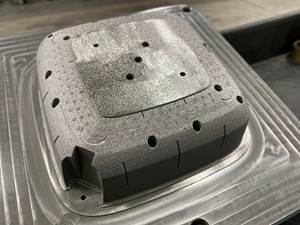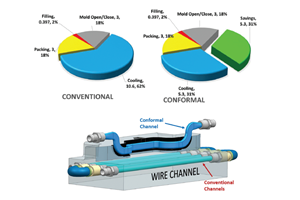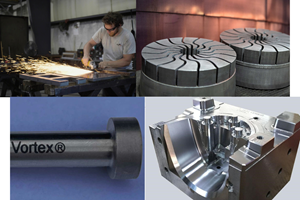Lessons and Learning Curves in Plastics 3D Printing
A learn-as-you-go approach has helped this custom molder grow its 3D printing capabilities.
A drive to provide customers with true velocity and superior value put Currier Plastics on the road to investing in 3D printing, and this technology has supported this philosophy for every aspect of product realization. However, the journey is laden with lessons learned.

A key consideration is part orientation on the build tray or platform. Orientation of the part impacts the amount of material used in the build and the placement of support material to optimize form, fit and function.
Since 1982, Currier has been a custom molder for industries including plastics packaging, beauty and cosmetics products, amenities, household consumables, electronic connectors, and medical measuring devices. The company invested in its first 3D printer, a Stratasys Objet 30, in 2012 as a tool for product design and development in its engineering department. The printer was used primarily to print prototypes of plastic bottles, jars, canisters, closures and lids. Its purchase was sparked by a desire to bring some capabilities in-house.
“The cost and amount of outside services and parts we were buying prompted our investment in in-house 3D printing capabilities,” explains Joel Sieber, Currier’s new product development manager.
The initial application was for part-design validation for a customer. However, the Currier team quickly discovered new uses for the technology beyond prototyping, including to produce quality assurance fixtures, automation fixturing, parts for the production floor, and cutting fixtures for the toolroom and secondary operations.
“The sky is the limit,” Sieber now says. “On a daily basis, the team asks, ‘Can we do this?’ and the answer is always, ‘Yes, we can.’”
For example, after purchasing the first 3D printer, Currier’s design and quality assurance teams collaborated to make a geometric dimensioning and tolerancing (GD&T) holding fixture for a new custom bottle design, which helped to simplify part inspection. On another occasion, an automation engineer who was working on a modification to a cap-closing station printed the base plate and flipper bar models overnight to validate the redesign. This reduced costs and shaved two weeks from the unit tool’s lead time.

urrier has pushed the limits of wall and part thickness. For amenity bottles, for example, a bit of trial and error taught the company that the part has a wall thickness minimum threshold of 0.040 inch. Any thinner than this and things get flimsy. Just cleaning it runs the risk of snapping the part or dropping and cracking it.
Today, the Currier team experiments not just with its own 3D printer, but with a range of 3D printing options available through suppliers, making this team “worth its weight in gold,” according to Gary Kieffer, VP of new product development. Although the company’s additive journey continues, its staff has already achieved considerable insight into implementing this technology for printing in plastics. What follows is some of what this company has learned.
First, Currier has realized the importance of recognizing a customer’s expectations of its additive manufacturing capabilities to prevent communication breakdowns and part failure down the line. “We have learned how valuable it is to understand the customer’s functional expectations for the part, so we educate the customer as we go,” Sieber explains. “Many customers do not fully grasp the design for manufacturability (DFM) process, especially as it relates to tooling design and mating components. We take the time to help the customer understand the complexities of form, fit and function.”
For example, a customer recently received some prototype bottles from Currier and requested 24 more, but with a smoother surface finish. This presented a problem, as the molder does not perform the post-finishing work (sanding, finishing and painting, for example) that would have been required to achieve the requested surface finish on these stereolithography (SLA) parts. The company therefore had to subcontract those services, adding time to the job. “This demonstrated the value of upfront communication to establish customer expectations in relation to our capabilities,” Sieber explains.

The only way to help determine an appropriate material inventory is to track history and usage. Every material has a shelf life, so verify the date stamp on the product to avoid waste.
Another key insight Currier has gained is understanding the importance of part orientation to the 3D printing process. Every additive machine has a build tray or platform, but the key to a successful and efficient build is how the part is oriented on the tray. “Remember the commercial that said, ‘If it fits, it ships’? Well, we use the same motto here. If it fits on the tray and within the envelope, it can build,” Kieffer says.
However, orientation of the part is important, as it impacts the amount of material used in the build and the placement of support material to optimize form, fit and function. Kieffer also stresses the importance of part orientation in reducing print time. A part oriented one way might take two hours to print, but the build could take significantly longer in another orientation.
Currier has also learned to allow for some trial and error in the process to optimize a product’s design, including pushing the limits of wall and part thickness. “For example, we learned that with our amenity bottles we have a wall thickness threshold of 0.040 inch. If we go any thinner, things start to get too flimsy. Then just holding the part while you’re trying to clean it in the cleanup tank, you run the risk of snapping the part or dropping and cracking it,” Sieber says.
An often overlooked aspect of 3D printing is material inventory control, in terms of both maintaining sufficient supply and ensuring that the material on hand has not expired.
“When we purchased the printer, we were unaware of the speed at which we’d use the material, so when building an inventory, we over-invested,” Sieber says. “We did not use the material as fast as anticipated, which resulted in expired material on our shelves.”
Every material has a shelf life and should include an expiration date stamp. Today’s machines are smart. They can read the date code on the material container and will not accept expired material. “So if you buy new material with a noted two-year shelf life, make sure it didn’t sit on the supplier’s shelf for a year before purchasing,” Sieber advises.

The only way to help determine an appropriate material inventory is to track history and usage. Every material has a shelf life, so verify the date stamp on the product to avoid waste.
To help determine an appropriate material inventory, he suggests tracking its usage. “You want to have enough material on hand to get you through your jobs and avoid anxiety about getting more,” he explains. Lead time for receiving material can be a short as two days, he adds.
In addition to planning for effective inventory management, there are a number of other variables that can impact a shop’s ability to maximize use of a 3D system, and they should be considered prior to the purchase of a machine. These variables include space constraints relevant to machine size, secondary finishing requirements, options for hazardous material disposal and fume evacuation, power requirements, noise levels, and usage and maintenance requirements. A machine’s material capacity also should be considered, as some builds may require more material than a machine’s capacity, requiring that material be replenished mid-job.
“You also need to monitor certain conditions within the printer that are critical to performance, such as head alignment, head cleaning, waste material containment, and maintenance intervals to keep the head cleaned and calibrated for accuracy,” Kieffer says. “The resolution is important, so keeping the area clean is important.”
Maintenance also is critical to maximizing any significant equipment investment, and a 3D printer is no exception. “The last thing you want to do is take an expensive machine and cause an issue that costs you time and money,” Kieffer says. “We have an annual service call from the printer supplier. They calibrate the machine, change all the fans and filters, and perform various maintenance items. It is critical to have the annual service performed by a qualified technician who can keep it in calibration.”
Location of equipment can help minimize maintenance needs. Currier conducts 3D printing in an office area rather than on the shop floor. According to Sieber, a manufacturing floor may not be suitable for a precision instrument. Machines that operate in a factory are exposed to more dust and dirt, which can impact performance.
Adding 3D printing capabilities requires a significant investment from a shop like Currier, so continually managing and controlling printer costs are essential. One way to help minimize these costs is to think beyond using the printer only for creating parts. Many other components can be produced from additive manufacturing. “For example, production components that don’t require a lot of stress, molds for casting, parts for robotics, prototypes, fixturing for quality labs, etc.” Sieber says. “The cost of a printer can be justified much faster than people think.”
Lastly, Currier views 3D printing as an ongoing educational process, much like implementing any new technology or strategy. It produces a learning curve for the entire company to understand the potential capability at its disposal. Currier recommends that users experiment with the technology, especially with producing value-added parts.
Steve Faes, a Currier CAD designer, recalls an incident on the production floor that shows how a learn-as-you-go approach to 3D printing can pay off. “The bottle capping station of our filling and closing machine had a damaged lead-in shoe with a complex surface curve,” he says. “A lead-in shoe is the first component on the rotary turret closer that comes in contact with the closure or cap when it is in the open state and begins to push the lid down, forcing the pintel into the orifice. We 3D-printed a temporary plastic replacement part on site that kept things running for three weeks while we waited for the damaged metal replacement part to come back from repair at an outside machine shop.”
Without the option of in-house 3D printing, Currier would have been out of production for three weeks on that one product. Now, when similar situations arise, the company has learned it can consider using its printer for more than just prototyping.
Related Content
MMT Chats: The Connection Between Additive Manufacturing Education and ROI
This MMT Chat continues the conversation with Action Mold and Machining, as two members of the Additive Manufacturing team dig a little deeper into AM education, AM’s return on investment and the facility and equipment requirements to implement AM properly.
Read MoreA 3D Printing Retrospective
A personal review of the evolution of 3D printing in moldmaking throughout the past 25 years.
Read MoreHow to Use Thermal Management to Improve Mold Cooling
A review of common mold cooling issues and possible solutions, including 3D printing applications.
Read MoreMold Materials, 3D Printing Technologies for Next-Gen Moldmaking
As moldmaking advances, so too do the materials and processes involved in their efficient production, including these latest mold materials and 3D printing technologies.
Read MoreRead Next
How to Use Continuing Education to Remain Competitive in Moldmaking
Continued training helps moldmakers make tooling decisions and properly use the latest cutting tool to efficiently machine high-quality molds.
Read MoreHow to Use Strategic Planning Tools, Data to Manage the Human Side of Business
Q&A with Marion Wells, MMT EAB member and founder of Human Asset Management.
Read MoreReasons to Use Fiber Lasers for Mold Cleaning
Fiber lasers offer a simplicity, speed, control and portability, minimizing mold cleaning risks.
Read More






















